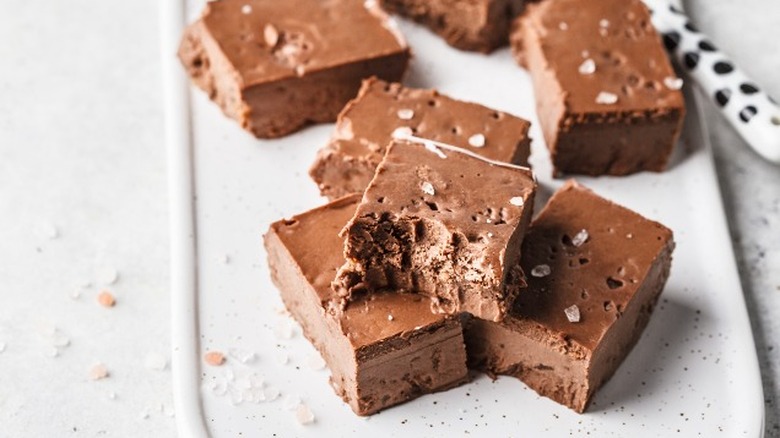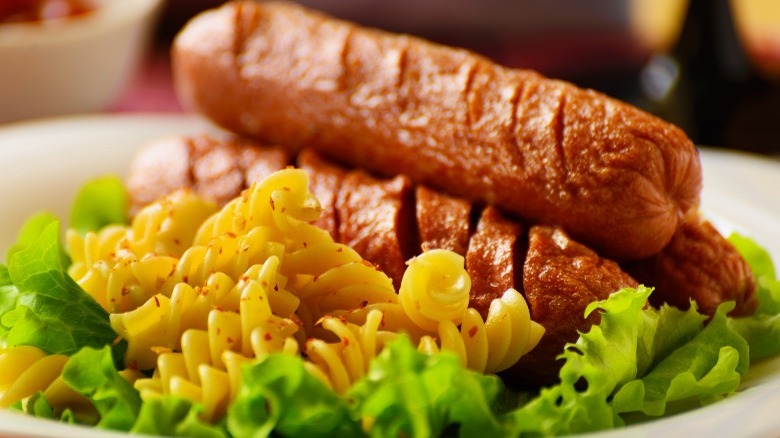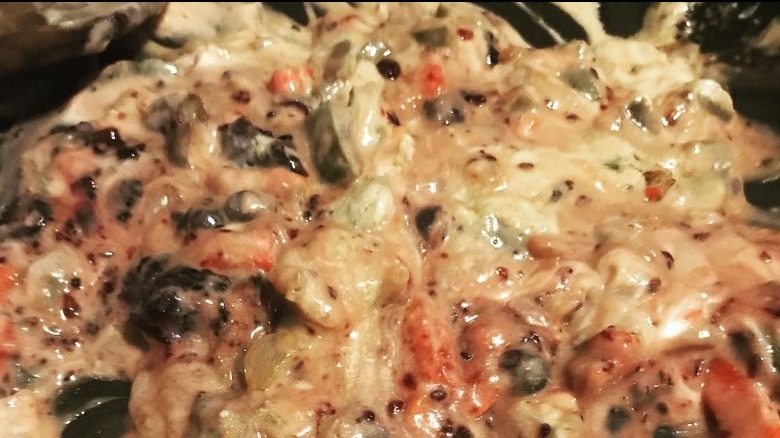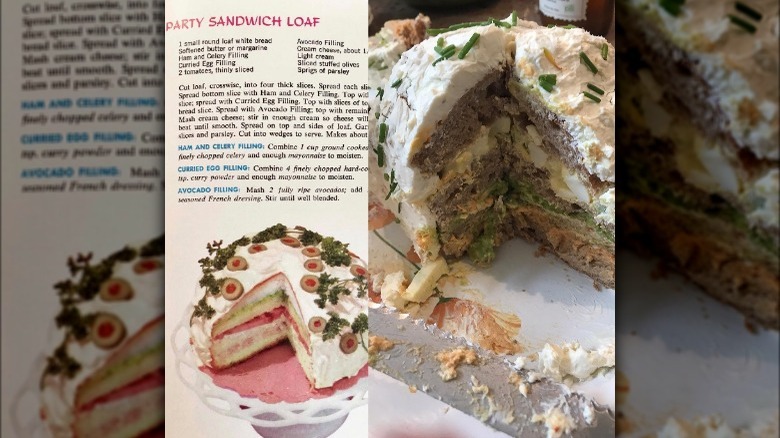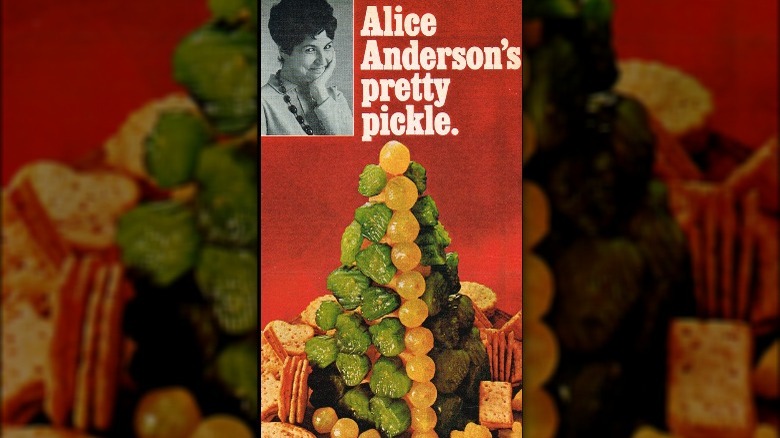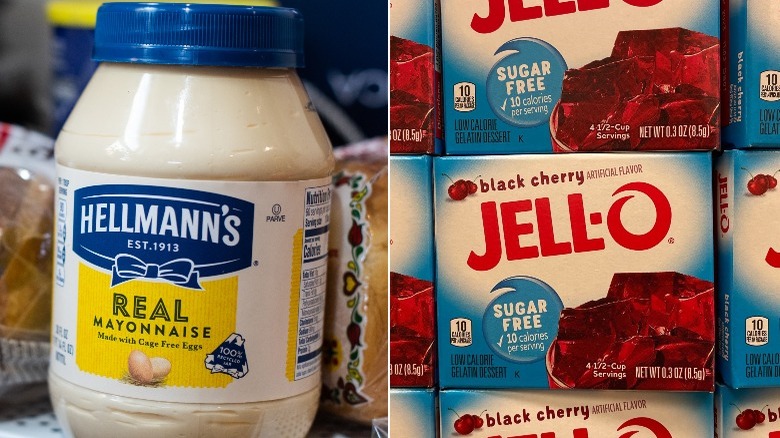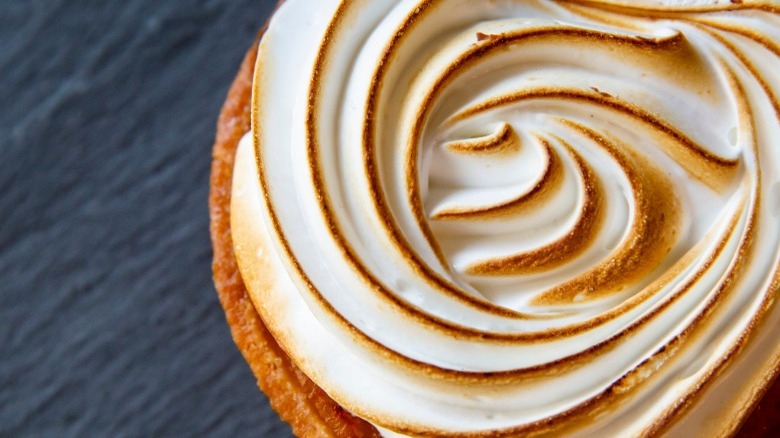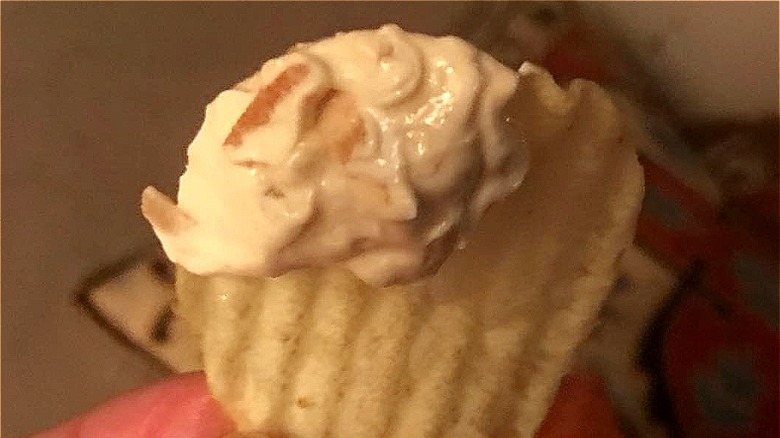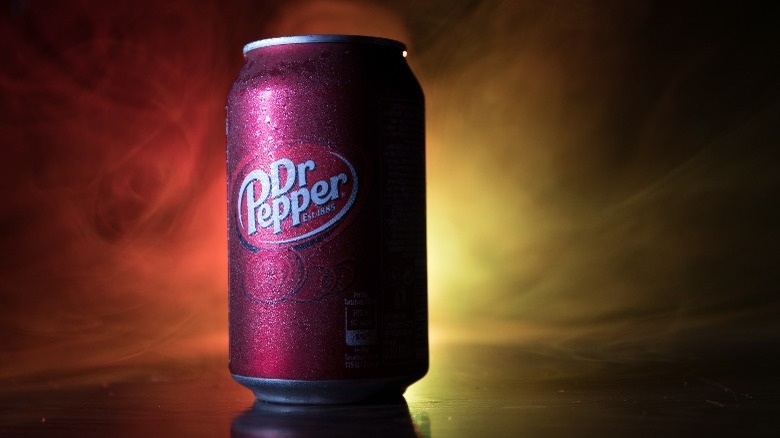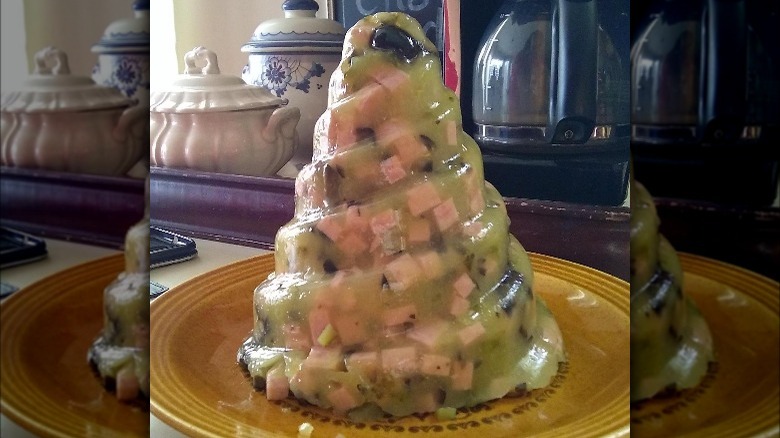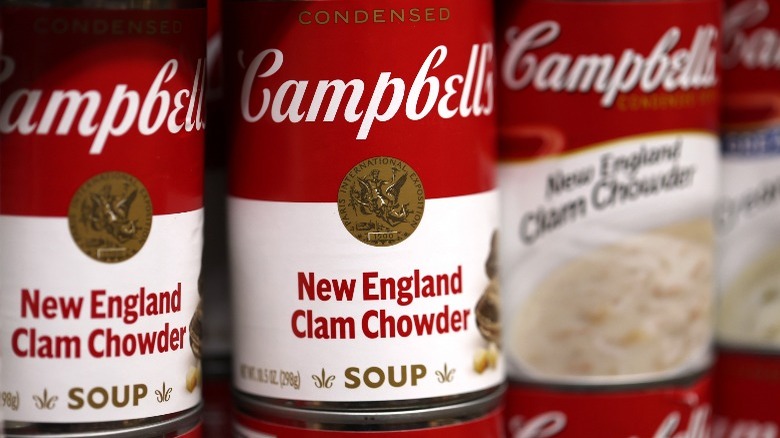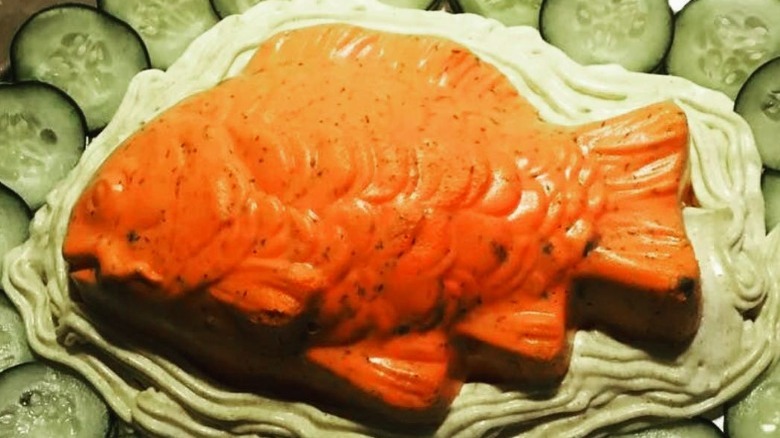Foods From The 1960s That Should Never Come Back
We may receive a commission on purchases made from links.
Creativity can take you far in life, and the 1960s launched dozens of fascinating ideas. New technology filled the shelves, fresh opportunities greeted the middle class, and a man walked on the moon. Anything was possible.
Just because you can do something, however, doesn't mean you should. It's a lesson Mary Shelley taught in "Frankenstein," and some of the food from the 1960s looked like they'd be right at home in that novel. It was a colorful decade, particularly in the kitchen, where advertisers pushed questionable recipes with their latest products onto the family table and home cooks reached for the stars (and gelatin).
While the world will always have room for the 1960s aesthetic, mini skirts, and the time's fascination with outer space, some of the food should stay in the past. These dishes didn't deserve a first introduction to society, and we don't think they deserve a reboot. Popular as they were in their day, they belong in memory, not modern recipes, and we hope these horrors never come back.
Beef fudge
Some foodstuffs are the stuff of legend: They are pure bliss, and they deserve a place of honor on the holiday cookie tray. Fudge has earned all those honors and more, but for some reason, someone, somewhere, presumably after a very bad day, decided nothing goes better with sugar, chocolate, and milk fat than beef.
Flavor aside, this is a question of texture. Even if — by some miracle — the sweet and savory balance into something bearable, do you really want to chew a mouthful of hamburger or leftover pot roast with your marshmallow fluff?
This offense to the dessert table comes from the 1967 edition of the Poll-Ette Hostess Cookbook, and credit goes to one Mrs. Florence E. Weist. Thanks, ma'am. Really.
If you like walnuts in your fudge, don't worry! The recipe calls for those, too. Imagine the joy of biting into a soft piece of fudge, finding the crunchy nuts you love, and then chewing the beef. It's like a meal in a mouthful. Wonka would be proud.
Weineroni Casserole
Karo syrup isn't as popular in the kitchen as it was in the 1960's, and that's probably a good thing. The goopy corn syrup still has its place in recipes for old-fashioned sweets and sauces, but the minds behind its old marketing campaigns thought it belonged in courses, even the main dish.
Thus was born the Weineroni Casserole. The recipe comes straight from the source. Karo printed it as an advertisement in the February edition of Ladies Home Journal in 1966, and it is everything you'd expect. There's pasta, and it has a full cup of Karo syrup in the sauce. You won't have to look hard for the wieners. Rather than chopping them up and mixing them in, the recipe suggests displaying them in a neat row along the top.
To be fair, the recipe also calls for bacon, and bacon makes everything better. It may not make your Weineroni casserole good enough for the people you love, though.
Deviled rice
Rice is a beautiful, versatile grain. It makes a thousand easy meals that taste great with little work. This dish is not one of them. It is devilish in smell and design. In Retro Food Ghoul's experiments, it looks like a slime creature from the era's science fiction films, so it may have deadly intent.
If you're ever in the mood to ruin three cups of perfectly good rice, first cook up some onions and green peppers with currant jelly, mustard, pimentos, Worcestershire sauce, and sour cream. Stir the fresh sludge into the rice and serve to unwanted guests. This is a great recipe to make when you want to ruin a relationship. It isn't even wholesome enough to qualify as a health food. The untold truth of Worcestershire sauce is that it's done dirty by this recipe.
Deviled rice appears in Miss Fluffy's Rice Cookbook from 1968. You'd never guess by the cutesy spoon-person waving a magic wand on the front that such horrors lie within. Never judge a book by its cover, but feel free to judge deviled rice for its poor life choices.
Party sandwich loaf
Lots of folks aspire to be the hostess with the mostest, but does all the mostest need to go in one dish? Meet the party sandwich loaf, a heaping mound of all good things gone wrong.
Imagine a baked Alaska, but instead of ice cream, there are layers of bread, spread, and filling. There are, in fact, three fillings, some more respectable than others. One features mashed avocado and French dressing. Another consists of ham, celery, and mayonnaise, while the final filling is nothing but hard-boiled eggs mashed with chili powder and even more mayonnaise. Tomatoes add some color between layers of Italian bread, and with all that moisture, it will be a miracle if the bread is anything but a soggy mess by the time the host cuts open this beast.
To make everything just a little worse (and harder to eat), the entire mound sports a thick icing of watered-down cream cheese. Sliced, stuffed olives decorate the top, glaring at anyone brave enough to try a slice like a collection of eyes. It's nearly Lovecraftian in the right light. We don't want to know how it would look in the wrong one.
The worst part may be the fact that the government is responsible for this abomination of a sandwich. More specifically, the Wisconsin Department of Agriculture is at fault for including this recipe in their 1964 Recipes from America's Dairyland cookbook. Wisconsin's dairy deserves better, and no party deserves to suffer this sandwich.
Pretty pickle tree
It's an alarming way to welcome guests, and it isn't clear how you eat it, but this evil piece of charcuterie certainly makes a statement. There are pickles, but they aren't pretty. Anchored by toothpicks, dozens of said pickles hang along the sides of a large wedge of cheese. It's supposed to look like a holiday tree, and in the recipe's defense, the pickles are green.
As for the garnish, well, who can argue with pickled onions and cauliflower? Most puzzling of all is the fact that it's designed to be shared, but the center is a single, triangular slab of cheese. Guests may pluck the pickles free, but they're supposed to get a bite of cheese, too. The recipe calls for crackers on the side. Maybe guests should just poke the cheese apart with the toothpicks, a death by a thousand stabs.
This questionable centerpiece is another gift from magazine ads. Heinz showcased the pickle tree in a 1967 issue of Chatelaine.
Mayo Jell-O salads
There's nothing wrong with cute shapes in gelatin. There's a big problem with mayo in gelatin, though, especially when it's sweet.
In this show-stopping meal, the cook layers goodies like shell macaroni, cauliflower, parsley, and shrimp in sweetened gelatin. Bad as that sounds, it only gets worse. The mayo serves as a decorative garnish, haunting each serving to ensure even the hardest stomachs experience the joys of rough ocean waves.
This offender comes from the June 1960 issue of Good Housekeeping, but it's hardly the only one of its kind. Hellman's is responsible for this colorful take on indigestion, but adding mayonnaise to jello was a fairly common culinary war crime in the era's kitchens. Don't worry if you prefer Miracle Whip to mayonnaise. There are recipes out there with your name on them, like the Cling-a-ling salad. It's yet another brand's ad-based recipe, so we all know who to blame.
Fish meringue pie
Who doesn't like a nice meringue pie? You don't. This is no tangy lemon treat, no chocolate delight, and certainly no key lime dream. These monsters were fish meringue pies.
If you were lucky, there are other ingredients in your fish pie potent enough to hide the ugly truth. Bacon, tomato, and egg work well together, and a newspaper recipe from Historic-Newspapers.co.uk's collection for fish meringue pie even included cheese. That would make a perfectly respectable breakfast pie if left in peace, but the fish pies of the 1960s were merciless, and they demanded meringue as well as fish.
Another recipe from The Meatless Cookbook (definitions have changed) actually calls for leftover or canned fish. Fresh fish need not apply. They have the slightest chance of turning out well. Because it's meatless, the pie gets no bacon, only cream of mushroom soup, mushrooms, and a little grated cheese to hide the old fish's many sins. Texture, smell, and taste could all be potential hazards. It also calls for the whipped egg whites to top it all off, because if you're going to suffer from food poisoning, you might as well make it fancy. Frankly, if there's fish under fluff, this is the biggest mistake you're making with meringue.
Blushing bowl
This is a shining example of a product trying to appeal to more customers with an inventive recipe better left on the drawing board with the rest of the bad ideas.
Begin by making California Dip with Lipton's Onion Soup powdered mix. This requires the powdered mix and some sour cream. Simple, right? So far so good. Now, ruin it all with horseradish and a squeeze of ketchup for color. Watch guests blush in horror. Recipe complete.
"When in doubt, add horseradish" isn't a saying. It isn't a good idea, either. Horseradish is a powerful ingredient that can sway any foodstuff towards good or evil, but misapplication will almost inevitably turn your dish towards the dark side. The ketchup is questionable, but comparatively tame.
No matter how cute the name, this is another instance of the Ladies Home Journal letting down its readership. It's a great way to ensure you never have to host the book club again, though.
Hot Dr Pepper
You've heard of mulled wine. This is like that, but worse. There is no alcohol to help you forget you're drinking something at the wrong temperature, there are no spices to change up the flavor to something new, and there are still bubbles. The truth about Dr Pepper's blend of 23 flavors is that they're better chilled.
Let's focus on the carbonation for a minute. Slightly flat, hot Dr Pepper that's lost significant fizz to the atmosphere as it heats has already surrendered an important element. Would it be better completely flat, though? Carbonation creates a sensation of motion in your mouth as the bubbles pop. Added to the warmth, it might feel alive, like an alien fighting for survival.
Companies were so sure the idea would catch on that they sold special glasses for serving hot Dr Pepper during holiday parties and get togethers. Soda pop never felt so fancy — or so wrong. Flat or bubbly, it's hard to imagine wanting a second glassful.
Sausage boaties
They look like something a proud seven-year-old would serve: American cheese folded around chunks of pineapple and wieners. As underwhelming as they are unappetizing, they appeared with all the gravity of a grown-up recipe in Marguerite Patton's 1967 set of family recipe cards. It's 28 in the egg and cheese category.
To impress guests with your elementary school finger food, you'll need pork sausages (hot dogs), processed cheese, chunks of pineapple, and a little chutney. Parsley and tomatoes are the recommended garnish, like an apology to your gut.
Construction (it isn't really cooking) is simple. The hot dog goes diagonally across a piece of cheese. A toothpick goes through the cheese on either side of the hot dog to hold it all together, and the pineapple chunks act like screws on the ends of each toothpick, preventing the cheese from sliding away to a better life. What about the chutney? If you're feeling ambitious, put a narrow cut in the top of each hot dog and fill it with the chutney. Don't worry if you missed that step. This is a meal everyone will try to forget.
Aspic
A strange idea possessed home cooks in the 1960s. It was like they believed anything accidentally dropped in gelatin belonged there, that it could work in harmony to create a passable, or even enjoyable, dinner. The difference between aspic and Jell-O begins with age, goes through branding, and ends with sugar and food coloring. The aspic is a centuries-old dish with a storied history, and while aspics do combine gelatin and savory foods like meat and vegetables, the 1960s took the idea and made something truly alarming.
Nothing suited leftovers like a dip in gelatin, and the greater the variety, the better the show. It really was about show, too. These jiggly abominations flopped out of the mold dressed to impress with colorful vegetables and fillings so strange, no neighbor had thought to add it before.
Sit and consider the problems. First, there's the temperature. Who wants their beef and carrots cold? Even if leftovers straight from the fridge sound nice on a hot day, do you really want that mixture of textures in your mouth? Savory gelatin on its own is an experience, but paired with chicken, it may just feel like coagulated fat.
Campbelled eggs
The 1960s were an innovative decade. Many discoveries and inventions of the era continue to make life better today. Some made things worse. For example, home cooks discovered canned cream soups are a simple way to ruin scrambled eggs.
Campbell's advertised lots of clever ways to make breakfast memorable. Most recipes called for three basic ingredients: eggs, butter, and canned soup. Hopefully, you like your eggs a little runny with surprise textures. Any soup would do for these recipes. Vegetable soup added some color to breakfast, and mushroom soup reminded everyone they were running late and didn't have time to stop for breakfast, actually, sorry. Chicken soup with eggs may be the least offensive, but it still sounds wrong.
Imagine a loving parent preparing a hot breakfast. You take a bite of your scrambled eggs and realize — they've been polluted. The worst part is that this idea isn't wholly awful, but the blatant disregard for the type of soup added to the eggs suggests a casual disregard for the value of the human taste bud.
Salmon and tuna mousse
Canned salmon and tuna may be a step below fresh seafood, but if you mix it with enough things and make it look like a fish, who will notice? So it has chunks of vegetables and a funky smell. Don't all fish?
To make salmon or tuna mousse, you need a little of many good things gone bad. In addition to your canned fish, a recipe of the time called for cream cheese, mayonnaise, A1 Sauce (guess who's responsible for this one), onion, celery, tomato soup, and a little gelatin to hold it all together. The celery and onion go in raw, by the way, because there's nothing like biting into an onion halfway through a mouthful of goopy fish ooze.
These fish mousse recipes were so popular there were special molds sold for them. How would the guests know it's salmon mousse if it isn't pressed into the approximation of an actual fish? Maybe we should have a moment of silence for the dinner parties of the 1960s.

